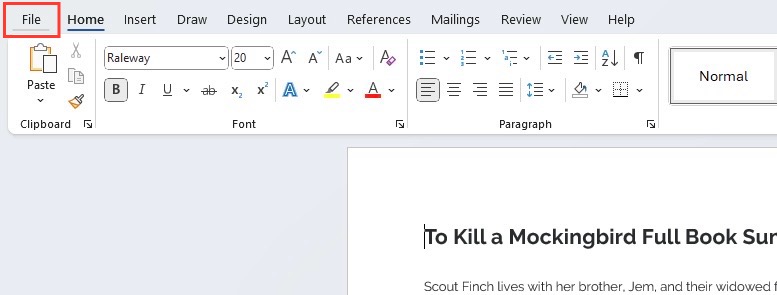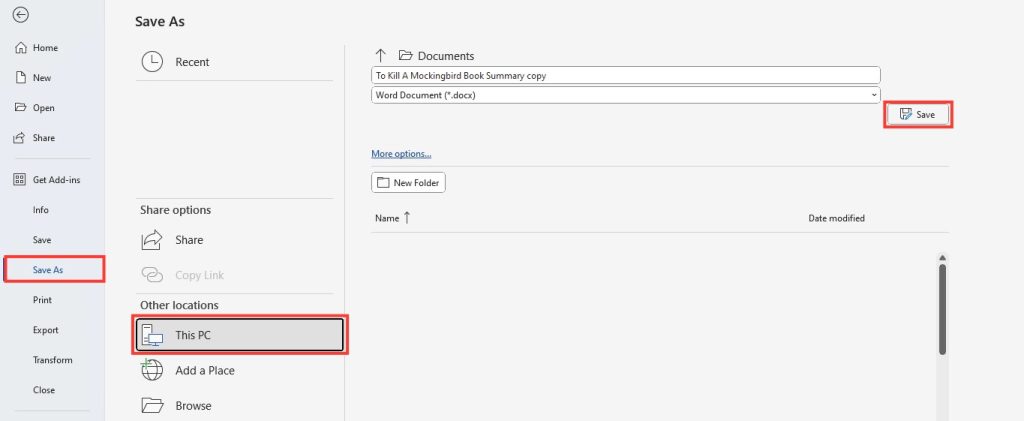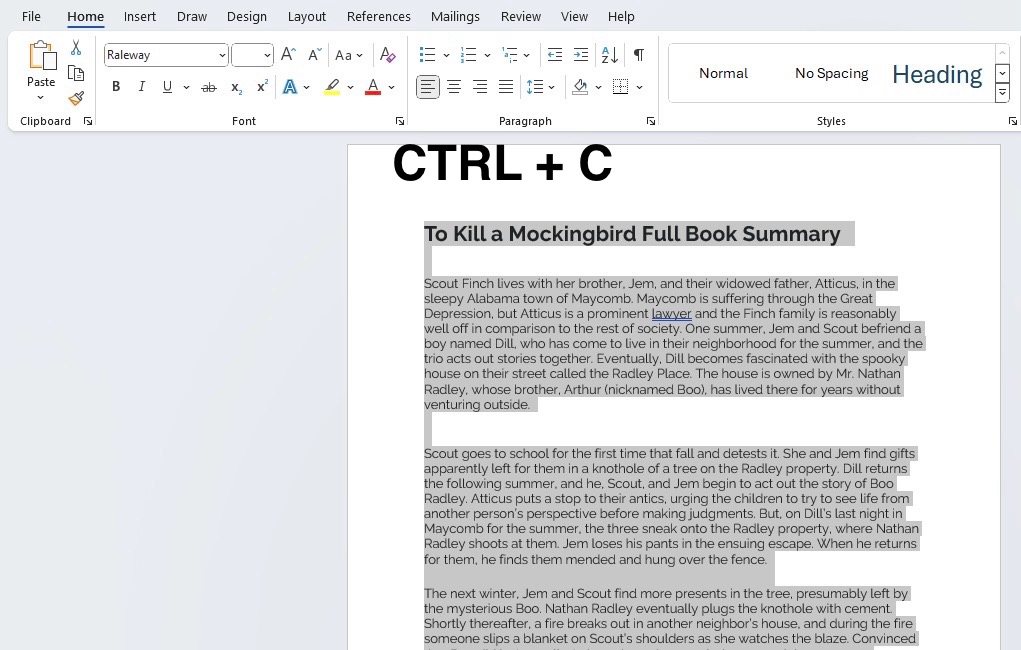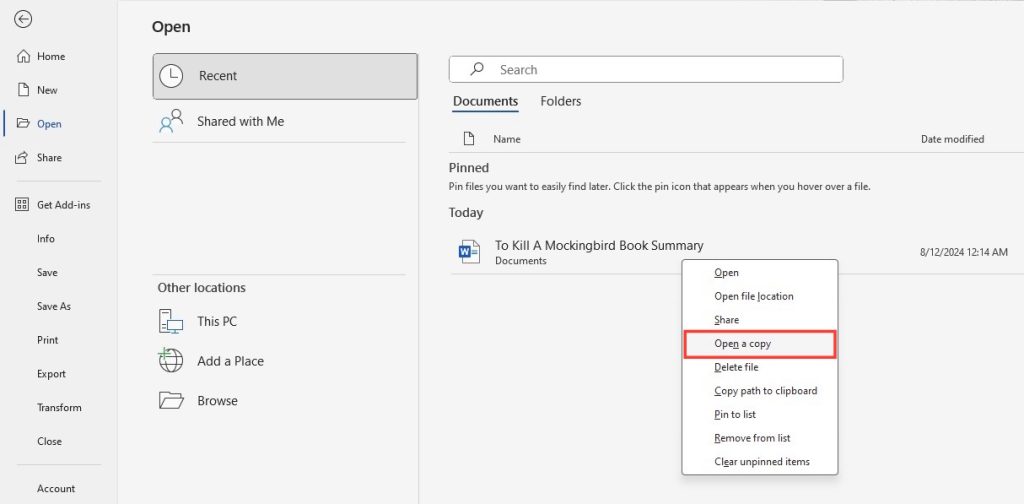Additionally, I make sure to close any unnecessary applications running on my computer to speed up the process and prevent system lags. Lastly, if I anticipate making many duplicates, I consider setting up a naming convention upfront. This will keep my files clearly labeled and versioned, avoiding a mix-up down the line.
Table of Contents
Step-by-Step Guide to Duplicating Word Documents
Using the ‘Save As’ Function
One of my go-to methods when I need to duplicate a Microsoft Word document is using the ‘Save As’ function.
STEP 1: Open the document you want to duplicate.
STEP 2: Click on ‘File’ in the top menu.
STEP 3: Select ‘Save As’ from the dropdown menu.
STEP 4: Rename the file to distinguish it from the original. You can add “Copy” or a version number to the name.
STEP 5: Choose the location on your computer where you want to save the duplicate.
STEP 6: Click ‘Save’ to create an identical copy of your document.
Remember, giving each file a unique name is crucial to prevent overwriting the original. I’ve found this method to be particularly useful when I’m working on templates or important forms that I use regularly but need to customize for different situations.
Copy and Paste: The Universal Method
When I’m working with single-page documents or need a quick and easy duplication, I often revert to the classic ‘copy and paste’ method.
Here’s a step-by-step breakdown:
STEP 1: Open the original Word document that you want to duplicate.
STEP 2: Press Ctrl + A to select all the content in the document.
STEP 3: Press Ctrl + C to copy the selected content to your clipboard.
STEP 4: Open a new Word document or navigate to the location where you want to paste the content.
STEP 5: Press Ctrl + V to paste the copied content into the new document.
This approach is universally known and mastered by many, and it serves perfectly for quick content transfers within Word. It’s reliable, straightforward, and doesn’t need any navigation through menus, which can be time-saving when speed is of the essence.
For documents longer than one page, this method still works well, but for multiple or more complex documents, I may look into more efficient ways of managing such tasks.
Tips to Ensure Efficient Document Management
Organizing Your Duplicates
Effective organization of duplicates is essential in my workflow to avoid confusion and clutter. I start by creating a specific directory or folder on my computer or cloud storage for the duplicates. If the duplicates are related to a particular project, I name the folder accordingly and locate it within the main project directory. Inside this folder, I stick to a consistent naming convention for each file, which normally incorporates the document’s name, version number, or date of duplication. This makes it much easier for me to track changes or retrieve a specific version of a document.
Additionally, I use file tags or colors where the operating system allows, improving visibility and categorization at a glance. Finally, I regularly perform clean-up sessions to remove unnecessary duplicates so they don’t consume valuable digital space or create clutter.
Version Control Best Practices
For maintaining a clean and organized document workflow, I adhere to strict version control best practices. At the core of these practices is the use of detailed file naming. This means including the version number, revision date, or author initials directly in the file name to prevent any mix-ups. Secondly, I utilize the document properties feature available in Word to add comments about the changes made in each version. This metadata can be invaluable when reviewing document history.
I also recommend leveraging the version history feature in cloud services like OneDrive, which can automatically keep previous versions of your documents. This way, I can restore older versions when needed without having to save each one manually. Regularly archiving and clearing out obsolete versions is also crucial to avoid overwhelming my storage with unnecessary files.
Practicing disciplined version control ensures that I can collaborate effectively with others, confidently track the progression of documents, and meet any required compliance standards related to document management.
Leveraging Word’s Advanced Features for Duplication
Open as Copy in Word
For a no-hassle duplication that keeps the original file untouched, I leverage Word’s ‘Open as Copy’ feature.
STEP 1: Close the document if it’s currently open.
STEP 2: Navigate to the ‘File’ tab in the program.
STEP 3: Choose ‘Open’ from the available options.
STEP 4: Locate the document you want to duplicate in the file explorer.
STEP 5: Right-click on the document to bring up the context menu.
STEP 6: Select ‘Open as Copy’ from the menu.
STEP 7: A new instance of the document will open, labeled with “Copy of” or something similar.
This method is particularly useful when dealing with sensitive or frequently used documents, such as templates or standard forms. I find it gives me peace of mind, knowing the original is preserved.
Of course, after creating the duplicate, I follow through with a ‘Save As’ to ensure the copy is named and stored correctly.
FAQs on Duplicating Microsoft Word Documents
Can I duplicate documents in batches using Word?
No, unfortunately, Word doesn’t provide a direct feature to duplicate documents in batches within the application itself. I’d have to duplicate each document individually following the methods I’ve outlined. However, I can use file management tools in my operating system to copy and paste multiple Word files at once, or I might look into third-party batch processing software if I have a large number of files to duplicate.
How do I save an existing Word document as a copy?
To save an existing Word document as a copy, I open the document and select ‘File’ from the top-left corner. Then, I click ‘Save As,’ choose the desired location for the duplicate, give it a new name if I wish, and click ‘Save.’ This creates a copy of the document while leaving the original file unaltered.
How do I ensure my document’s format isn’t affected when duplicating?
To ensure my document’s format remains intact when duplicating, I use the ‘Save As’ feature instead of copy-pasting text into a new file, which can sometimes alter formatting. Additionally, if I work across different computers or Word versions, I maintain the document’s format by saving it as a PDF or using Word’s ‘Compatibility Mode.’ This preserves the layout exactly as I intended.
John Michaloudis is a former accountant and finance analyst at General Electric, a Microsoft MVP since 2020, an Amazon #1 bestselling author of 4 Microsoft Excel books and teacher of Microsoft Excel & Office over at his flagship MyExcelOnline Academy Online Course.











